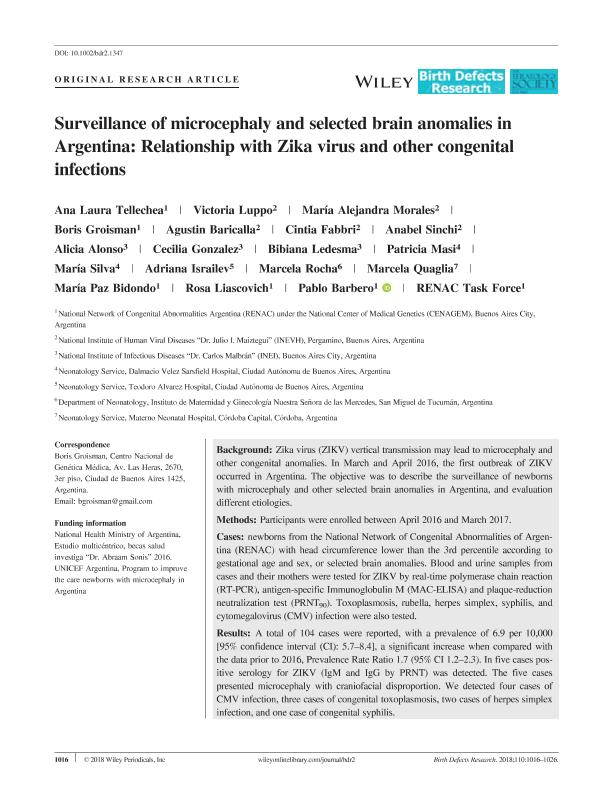Artículo
Surveillance of microcephaly and selected brain anomalies in Argentina: Relationship with Zika virus and other congenital infections
Tellechea, Ana Laura; Luppo, Victoria; Morales, Maria Alejandra; Groisman, Boris ; Baricalla, Agustin Ariel
; Baricalla, Agustin Ariel ; Fabbri, Cintia; Sinchi, Anabel; Alonso, Alicia Maria; Gonzalez, Cecilia; Ledesma, Bibiana; Masi, Patricia; Silva, María; Israilev, Adriana; Rocha, Marcela; Quaglia, Marcela; Bidondo, Maria Paz; Liascovich, Rosa
; Fabbri, Cintia; Sinchi, Anabel; Alonso, Alicia Maria; Gonzalez, Cecilia; Ledesma, Bibiana; Masi, Patricia; Silva, María; Israilev, Adriana; Rocha, Marcela; Quaglia, Marcela; Bidondo, Maria Paz; Liascovich, Rosa ; Barbero, Pablo Miguel
; Barbero, Pablo Miguel
 ; Baricalla, Agustin Ariel
; Baricalla, Agustin Ariel ; Fabbri, Cintia; Sinchi, Anabel; Alonso, Alicia Maria; Gonzalez, Cecilia; Ledesma, Bibiana; Masi, Patricia; Silva, María; Israilev, Adriana; Rocha, Marcela; Quaglia, Marcela; Bidondo, Maria Paz; Liascovich, Rosa
; Fabbri, Cintia; Sinchi, Anabel; Alonso, Alicia Maria; Gonzalez, Cecilia; Ledesma, Bibiana; Masi, Patricia; Silva, María; Israilev, Adriana; Rocha, Marcela; Quaglia, Marcela; Bidondo, Maria Paz; Liascovich, Rosa ; Barbero, Pablo Miguel
; Barbero, Pablo Miguel
Fecha de publicación:
19/06/2018
Editorial:
Wiley-liss, div John Wiley & Sons Inc.
Revista:
Birth Defects Research Part A: Clinical and Molecular Teratology
e-ISSN:
2472-1727
Idioma:
Inglés
Tipo de recurso:
Artículo publicado
Clasificación temática:
Resumen
Background: Zika virus (ZIKV) vertical transmission may lead to microcephaly and other congenital anomalies. In March and April 2016, the first outbreak of ZIKV occurred in Argentina. The objective was to describe the surveillance of newborns with microcephaly and other selected brain anomalies in Argentina, and evaluation different etiologies. Methods: Participants were enrolled between April 2016 and March 2017. Cases: newborns from the National Network of Congenital Abnormalities of Argentina (RENAC) with head circumference lower than the 3rd percentile according to gestational age and sex, or selected brain anomalies. Blood and urine samples from cases and their mothers were tested for ZIKV by real-time polymerase chain reaction (RT-PCR), antigen-specific Immunoglobulin M (MAC-ELISA) and plaque-reduction neutralization test (PRNT90). Toxoplasmosis, rubella, herpes simplex, syphilis, and cytomegalovirus (CMV) infection were also tested. Results: A total of 104 cases were reported, with a prevalence of 6.9 per 10,000 [95% confidence interval (CI): 5.7?8.4], a significant increase when compared with the data prior to 2016, Prevalence Rate Ratio 1.7 (95% CI 1.2?2.3). In five cases positive serology for ZIKV (IgM and IgG by PRNT) was detected. The five cases presented microcephaly with craniofacial disproportion. We detected four cases of CMV infection, three cases of congenital toxoplasmosis, two cases of herpes simplex infection, and one case of congenital syphilis. Conclusion: The prevalence of microcephaly was significantly higher when compared with the previous period. The system had the capacity to detect five cases with congenital ZIKV syndrome in a country with limited viral circulation.
Palabras clave:
ARGENTINA
,
CONGENITAL ANOMALIES
,
CONGENITAL INFECTIONS
,
MICROCEPHALY
,
ZIKA VIRUS
Archivos asociados
Licencia
Identificadores
Colecciones
Articulos(SEDE CENTRAL)
Articulos de SEDE CENTRAL
Articulos de SEDE CENTRAL
Citación
Tellechea, Ana Laura; Luppo, Victoria; Morales, Maria Alejandra; Groisman, Boris; Baricalla, Agustin Ariel; et al.; Surveillance of microcephaly and selected brain anomalies in Argentina: Relationship with Zika virus and other congenital infections; Wiley-liss, div John Wiley & Sons Inc.; Birth Defects Research Part A: Clinical and Molecular Teratology; 110; 12; 19-6-2018; 1016-1026
Compartir
Altmétricas



